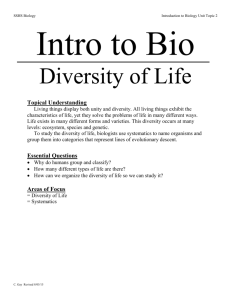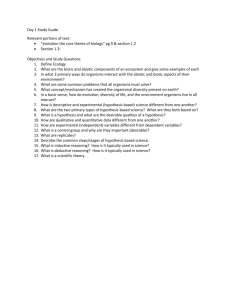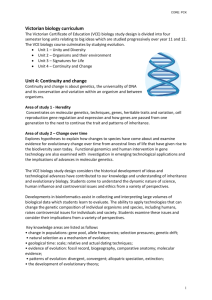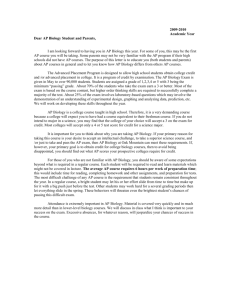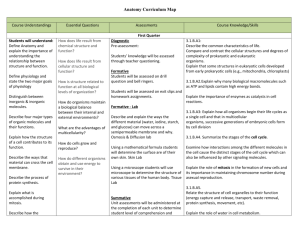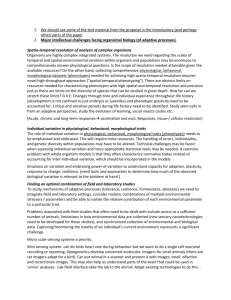biological sciences outcomes - Central Washington University
advertisement
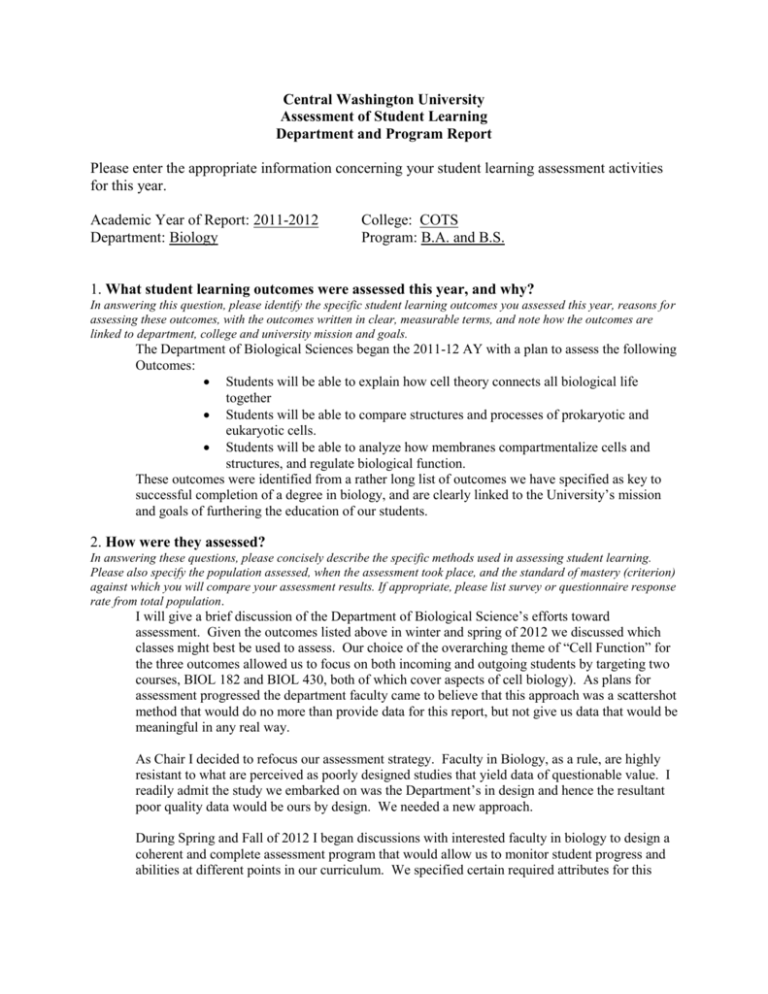
Central Washington University Assessment of Student Learning Department and Program Report Please enter the appropriate information concerning your student learning assessment activities for this year. Academic Year of Report: 2011-2012 Department: Biology College: COTS Program: B.A. and B.S. 1. What student learning outcomes were assessed this year, and why? In answering this question, please identify the specific student learning outcomes you assessed this year, reasons for assessing these outcomes, with the outcomes written in clear, measurable terms, and note how the outcomes are linked to department, college and university mission and goals. The Department of Biological Sciences began the 2011-12 AY with a plan to assess the following Outcomes: Students will be able to explain how cell theory connects all biological life together Students will be able to compare structures and processes of prokaryotic and eukaryotic cells. Students will be able to analyze how membranes compartmentalize cells and structures, and regulate biological function. These outcomes were identified from a rather long list of outcomes we have specified as key to successful completion of a degree in biology, and are clearly linked to the University’s mission and goals of furthering the education of our students. 2. How were they assessed? In answering these questions, please concisely describe the specific methods used in assessing student learning. Please also specify the population assessed, when the assessment took place, and the standard of mastery (criterion) against which you will compare your assessment results. If appropriate, please list survey or questionnaire response rate from total population. I will give a brief discussion of the Department of Biological Science’s efforts toward assessment. Given the outcomes listed above in winter and spring of 2012 we discussed which classes might best be used to assess. Our choice of the overarching theme of “Cell Function” for the three outcomes allowed us to focus on both incoming and outgoing students by targeting two courses, BIOL 182 and BIOL 430, both of which cover aspects of cell biology). As plans for assessment progressed the department faculty came to believe that this approach was a scattershot method that would do no more than provide data for this report, but not give us data that would be meaningful in any real way. As Chair I decided to refocus our assessment strategy. Faculty in Biology, as a rule, are highly resistant to what are perceived as poorly designed studies that yield data of questionable value. I readily admit the study we embarked on was the Department’s in design and hence the resultant poor quality data would be ours by design. We needed a new approach. During Spring and Fall of 2012 I began discussions with interested faculty in biology to design a coherent and complete assessment program that would allow us to monitor student progress and abilities at different points in our curriculum. We specified certain required attributes for this assessment that must be met in order to have buy-in across the department. These attributes were: 1) Assessment must be hard-wired into specific courses so that it occurs every time the course is offered 2) Assessment must address the three categories of outcomes: Knowledge, Skills, Disposition 3) Assessment data must be amenable to aggregation across the curriculum (e.g. 1 st year students to 4th year students), or across the outcomes (looking at all Skills outcomes, for example), or to both such aspects at once. 4) The assessment plan must absolutely not increase faculty work. This is the critical aspect for a faculty that is already overworked. A) What methods were used? We formed an assessment committee. The committee decided to use a new instrument available on BlackBoard called WayPoint. The committee edited and improved our agreed upon departmental outcomes and then modified these to fit into the three categories Knowledge, Skills, and Dispositions. Each of these categories have sub categories which are then further divided (see attached tables 1, 2 & 3). The tables presented here, when complete, will have a list of trailing columns that contain all of our classes. Using this matrix we will specify which outcomes are addressed and in which classes for a given assessment year. While we’re finalizing this table we are also developing rubrics for grading assessment instruments for all of the outcomes. These instruments will be uploaded for use on WayPoint. Because our department has accepted this model by explicit vote we will be able to identify those courses and times in our curriculum that we want to sample. Identified courses will include one or more assessment tools and these will be hardwired into their syllabi, thus assuring the participation of faculty and the completeness of the data. We plan on calibrating ourselves in the grading and use of the rubrics so that we have a statistically valid measurement of our students and program. For ease of use and reference the outcomes presented in Tables 1, 2, & 3 each have a shorthand name. For example in the Knowledge outcomes, K.3-1 indicates the outcome “Students will be able to describe how genetic information flows from nucleic acids to amino acids to biological characteristics and physical traits”. When we sample this outcome (sampled at several places in the curriculum), we should be able to discover how student success with this outcome changes with time. Using WayPoint we will also be able to relatively easily subsample and discover, for example, skills acquisition of transfer students versus native CWU students. Or, perhaps more interesting, we could disaggregate the data so that we can compare correlations of student scores in K.9-1 Use the scientific method to explore biological phenomena and S.1-1 Distinguish among hypothesis, prediction, and theory. This sort of data manipulation is thrilling to a department that at once abhors awkward and questionable data, and loves analyzing coherent and valid data. In short, we think we might even like this! I ask University Assessment to have an open mind about my decisions and our actions. When faculty believe that a course of action does not yield valuable data they are not inclined to participate. I support my department in this view, and I agree with it. Our plan, briefly described above, includes a framework on which the Department has voted and accepted (12 yea, 1 abstention). Our plan has dynamic faculty steering it (Dr. Quittadamo, Dr. Raubeson, and Dr. Wagner) and they have made great headway toward its implementation. We plan on beginning data collection as early as Spring 2013. It will take a few years to build a long term view of our students and our program, but all voyages require a first step to begin. B) Who was assessed? NA C) When was it assessed? NA 3. What was learned? NA 4. What will the department or program do as a result of that information? NA 5. What did the department or program do in response to last year’s assessment information? NA 6. Questions or suggestions concerning Assessment of Student Learning at Central Washington University: Table 1. Knowledge Outcomes. BIOLOGICAL SCIENCES OUTCOMES: KNOWLEDGE Students will be able to: K1 PHYSICAL SCIENCES: Physics, chemistry, and biochemistry form the basis of biological processes. 1 Relate physical structure to function across all levels of biological organization. 2 Illustrate how atomic and molecular forces influence biological molecules and structures. 3 Diagram how physical interactions affect energy flow, cell replication, gene expression, and cell communication. 4 Apply physics, thermodynamics, and biochemistry principles to biological structures and processes. 5 Explain how chemical and physical properties of water influence biological life. K2 CELLS: Cells are the basic unit of life. 1 Explain how cell theory connects all biological life together. 2 Compare structures and processes of prokaryotic and eukaryotic cells. 3 Analyze how membranes compartmentalize cells and structures and regulate biological function. 4 Evaluate how cellular components and organelles differentiate function and contribute to biological fitness. 5 Diagram how cells store, use, and pass genetic information to the next generation. 6 Summarize how cells transform and use energy via cellular respiration and photosynthesis. 7 Analyze how different structures and processes contribute to cell communication. K3 GENETICS: Information from genes controls organismal inheritance, development, and form. 1 Describe how genetic information flows from nucleic acids to amino acids to biological characteristics and physical traits. 2 Illustrate how genetic information can produce different patterns of inheritance. 3 Analyze genetics data and apply suitable methods to determine modes of inheritance and solve other genetics problems. 4 Relate the chromosomal basis of mitosis and meiosis to generation of genetic diversity. 5 Contrast the mechanistic processes of gene replication and gene expression. 6 Explain how a cascade of genetic information is used to control cellular and organismal development. K4 FORM and FUNCTION: Organismal structure strongly influences organismal function. 1 Identify the prominent anatomical structures of the major phyla of organisms. 2 Differentiate basic growth and development patterns among the major taxonomic groups. 3 Describe the major physiological systems of organisms and how these systems regulate an organism’s internal environment. 4 Analyze how organisms perceive and respond to environmental conditions. 5 Evaluate how integration of anatomical structures and physiological responses are influenced by natural selection. K5 EVOLUTION: The diversity of life arose from common ancestors. 1 Explain evolutionary theory including natural selection and its influence across all levels of biological organization. 2 Quantify changes in the genetic composition of populations that result from evolution. 3 Evaluate whether an adaptation is adaptive and offer alternative explanations for complex structures. 4 Compare different mechanisms of speciation and the various ways that biologists define species. 5 Explain how macroevolutionary changes occur across evolutionary time. 6 Analyze evidence used to support serial endosymbiosis theory and how eukaryotes evolved from prokaryotes. 7 Apply evolutionary principles and hypotheses to test a wide range of biological phenomena. K6 DIVERSITY: Life on earth is related and highly varied. 1 Explain how species composition on Earth has changed in response to geological events shown by the fossil record. 2 Apply systematics and phyogenetic theory to interpret the evolutionary history or organisms. 3 Evaluate the evidence used to construct a phylogenetic tree for the domains and kingdoms of life. 4 Compare the major groups of prokaryotes and protists, their roles in the biosphere, and difficulties involved in their classification. 5 Apply phylogenetic concepts, methods and multiple defining characteristics to classify organisms into taxon. K7 ECOLOGY: All living organisms, including humans, affect and are affected by their abiotic and biotic environments. 1 Explain the different ways organisms respond to their abiotic environments. 2 Analyze the main features of populations, including population structure, growth, and dynamics. 3 Analzye how species interact within ecological communities, and how communities change over time. 4 Compare the major biomes and aquatic ecosystems of Earth. 5 Evaluate the relative biotic impacts of biogeochemical cycles and how human activities influence these cycles. 6 Apply the laws of thermodynamics to explain how energy flows through ecosystems. K8 1 2 3 K9 1 2 3 4 5 6 K10 1 2 3 4 LEVELS OF ORGANIZATION: Living systems are viewed at different levels of biological scale and classified using chemical, cellular, physiological, organismal, and ecological features. Summarize the inherent properties of each level of biological scale. Explain how emergent properties of one level can create organizational patterns in other levels. Analyze how physical and chemical properties of biotic and abiotic environments affect organization across the scale of biological life. SCIENTIFIC METHOD: Biologists use scientific methods to investigate the natural world. Use the scientific method to explore biological phenomena. Distinguish between a scientific hypothesis and a scientific theory. Interpret scientific data and analyses in order to make informed conclusions. Convey information about a variety of scientific techniques and how they are used to answer biological questions. Evaluate the roles of inductive and deductive logic in biological investigation (making progress in science). Describe key historical experiments and studies that have led to current understanding of biology. APPLICATION and AWARENESS: Humans are part of the biological world and potentially affect all levels of biological organization. Describe a variety of careers in biology and the preparation required for them. Examine their place in the biological world. Use biological knowledge to understand how the activities of human society affect the health and diversity of biological systems. Apply scientific evidence to debates on societal and ethical implications of the applications of biological technology. Table 2. Skills Outcomes. BIOLOGICAL SCIENCES OUTCOMES: SKILLS Students will be able to: S1 1 2 3 4 5 6 7 8 S2 1 2 3 4 5 6 7 8 9 10 11 12 13 Conduct scientific inquiry as a means of understanding the natural world. Distinguish among hypothesis, prediction, and theory Distinguish between fact and opinion. discuss the roles of inductive and deductive reasoning in scientific inquiry distinguish between science and other ways of knowing identify questions that can be addressed by science express appropriate scientific skepticism describe the origin and progression of scientific knowledge distinguish between science and pseudoscience Students will develop basic scientific skills design tests for hypotheses design data collection protocols conduct a lab or field experiment ["experiment" involves manipulating variables; replicates, controls] make and record careful and accurate observations use the metric system calculate the appropriate weights and volumes for specific molar, molal, and percent biological solutions; accurately prepare these solutions Correctly use standard lab equipment compound microscope dissecting microscope micro-pipetter pH meter analytical (?) balance Centrifuge Spectrophotometer laminar flow/ biol. safety hood identify a specimen using a dichotomous key construct (hand-drawn) graphs, tables, or charts to express relationships among variables use computer software to display relationships among variables prepare drawings, diagrams, or sketches based on observation maintain a well-organized and appropriately detailed laboratory or field notebook troubleshoot protocols 14 demonstrate safe and legal lab & field practices S3 1 2 3 4 5 6 7 8 9 10 S4 1 2 3 Students will demonstrate the ability to reason analytically formulate reasonable hypotheses based on observations apply analysis, inference, and evaluation skills to solving problems draw appropriate inferences from data. demonstrate the ability to use inductive reasoning by formulating appropriate generalizations apply terminology and conceptual understanding to novel situations apply integrated biological and chemical concepts to biological problem-solving describe and apply mathematical models, statistics and other quantitative tools to biological problems use data (e.g., graphs, tables, maps) to identify and interpret patterns in nature describe and evaluate arguments on opposing sides of a controversy evaluate the use of statistics in published literature Students will be able to communicate effectively through writing and speech use appropriate biological terminology (including biological nomenclature) in oral and written work employ appropriate communication styles for audience and situationb write a well-organized, concise document in appropriate scientific format - LAB REPORT REVIEW PAPER give a well-organized, concise oral presentation in appropriate format use scientific databases (such as Web of Science or Biological Abstracts) to find primary references to support or refute an idea prepare an argument supported with evidence demonstrate the ability to communicate and work effectively as a team member use relevant metaphors or analogies to explain or clarify biological concepts design an effective and professional poster presentation in scientific format participate effectively in group discussions of scientific issues Students will exhibit the characteristics of a scholar demonstrate the self-discipline and persistence necessary to meet challenges demonstrate academic honestyd differentiate between appropriate use of other work and plagiarism critically evaluate strengths and weaknesses in scientific literature engage in self-assessment of learning and of intellectual developmente ask questions and use appropriate sources of information to answer them be able to explain biological concepts and processes to both biologists and others discuss the consequences of the applications of science in society synthesize ideas from a body of literature 4 5 6 7 8 9 10 S5 1 2 3 4 5 6 7 8 9 Table 3. Disposition Outcomes. BIOLOGICAL SCIENCES OUTCOMES: DISPOSITIONS Students will be able to: D1 1 2 3 4 D2 1 2 3 4 D3 1 2 3 4 Integrity Incorporate professional ethics into daily scientific practice (don't cook the data) Learn to take proper credit and not take improper credit for work done by others No cheating on assignments, exams and other assessments Professionalism Contributes productively to team Follows through on commitments Treats faculty and peers with respect Willingness to approach tasks in an organized and skillful manner Curiosity Incorporate professional ethics into daily scientific practice (don't cook the data) Learn to take proper credit and not take improper credit for work done by others No cheating on assignments, exams and other assessments D4 1 2 3 4 5 D5 1 2 3 4 D6 1 2 3 4 D7 1 2 3 4 Open-mindedness Contributes productively to team Follows through on commitments Treats faculty and peers with respect Follows professional etiquette Accepts professional criticism Evidence-based Decision-making Incorporate professional ethics into daily scientific practice (don't cook the data) Learn to take proper credit and not take improper credit for work done by others No cheating on assignments, exams and other assessments Creativity Takes sometimes unconventional approaches to solving problems Frame scientifically suitable research questions from observations Treats faculty and peers with respect Follows professional etiquette Scholarly Behavior Appreciate the importance of a deep, current, and broad-based knowledge of biology Maintain currency in modern biological discoveries No cheating on assignments, exams and other assessments Tendency to be engaged and well prepared





